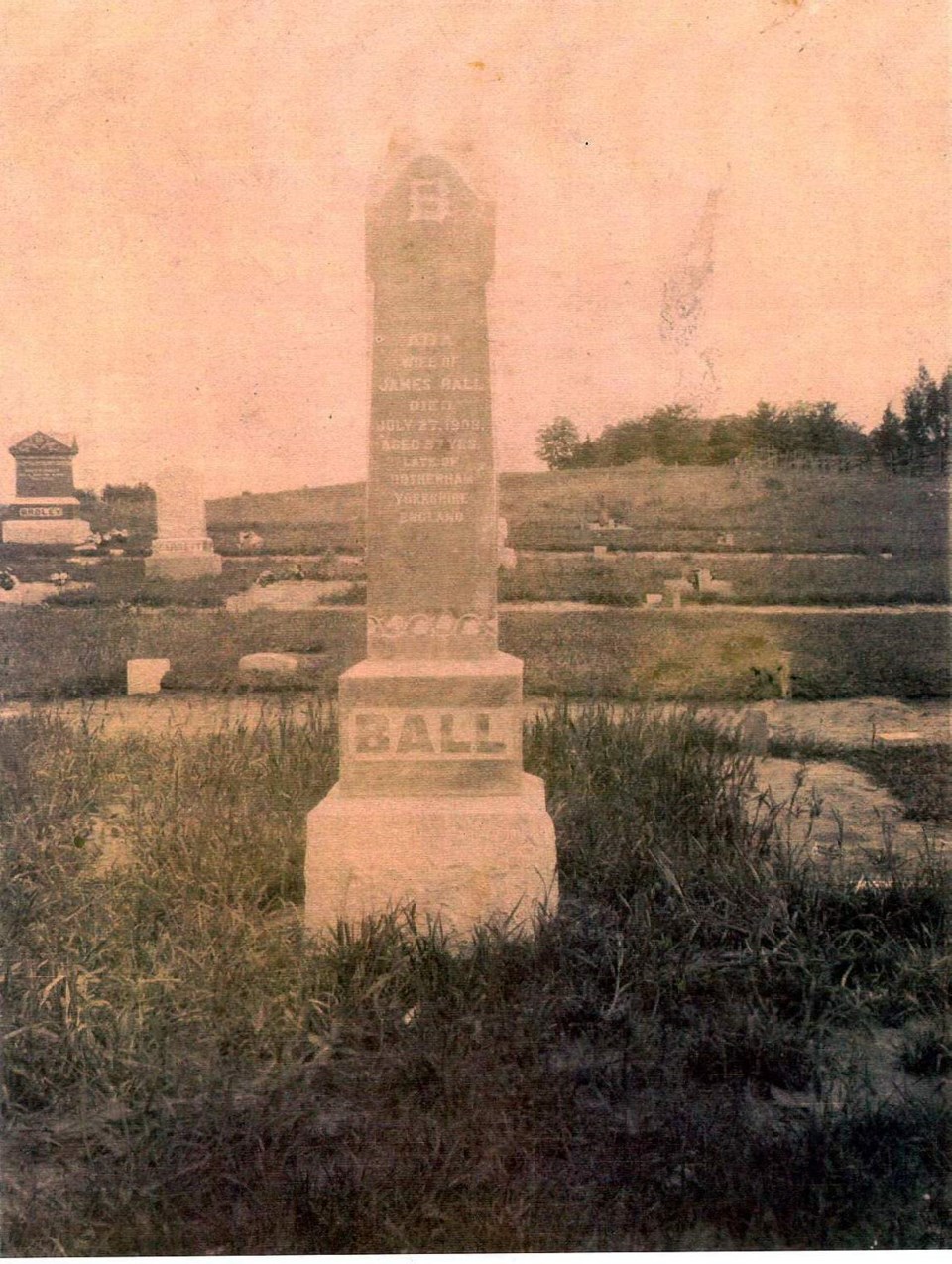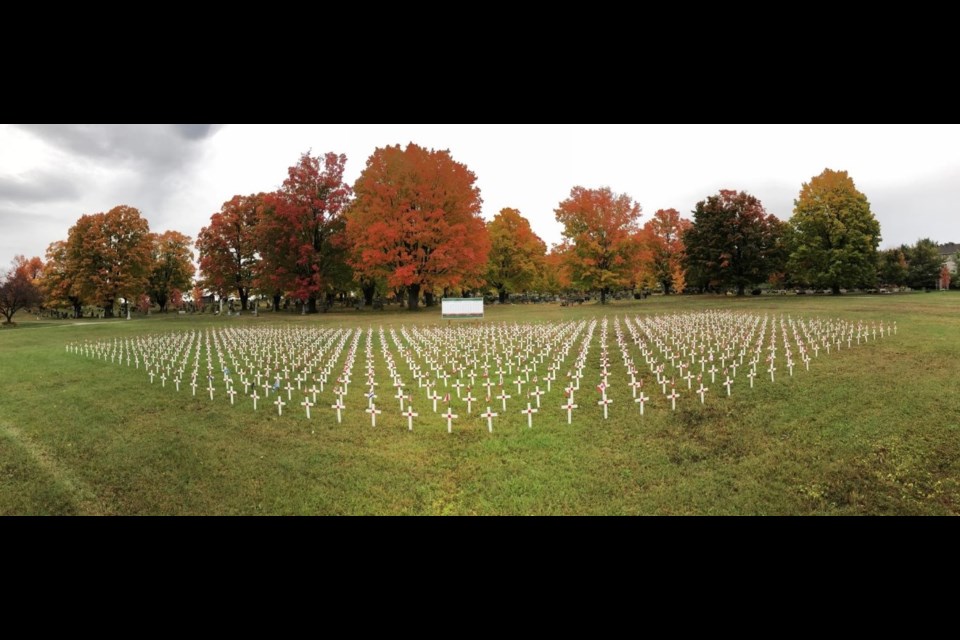You may pass by the Lakeview Cemetery every day if you travel along King Street in Midland.
What you may not know is that it’s one of the area’s oldest cemeteries, and it’s the final resting place of at least one former Mayor of Midland, a Member of Parliament, the painter William J. Wood, and many veterans.
There are 900 white crosses bordering the front of the cemetery in honour of any veteran that served in any war.
“Less the German veterans, of which we do have some,” says Michael Ahrens, the superintendent at Lakeview Cemetery.
Ahrens has worked at the cemetery for more than 40 years, and takes pride in the memorializing of Midland’s veterans, who he says could have fought in any war from the Civil War, to the Korean War, and the Second World War.

Ahrens recalls that some of the efforts to secure monuments for at least 10 or more unmarked graves came from the good work of Charlie Beman, a Second World War veteran.
“He was a volunteer and a vet. He was also the highest ranking soldier that came out of the Midland area,” says Ahrens.
Ahrens recalls a story that Beman told him about his work with German prisoners of war that were sent to internment camps in Canada after they were captured by English forces.
The story illustrates the xenophobia that permeated Germany at the time of the Second World War, and a complete lack of understanding that existed about Canada at the time, he says.
“While marching, a column of German soldiers, from different branches of the German military from the army, the navy, and the air force ... he was marching to a lake so they could get cleaned up and have a swim," he explained.
During the march, a German officer broke rank and marched beside Beman. In Oxford English, the well educated German officer said, ‘You know, my men can easily take out your four riflemen.’
Beman had to think quickly, and he said, "Well, they’re not here for you."
The German officer had a puzzled look on his face, and he asked: "Why are these four riflemen with us?"
"Well, they're here in case the Indians attack," he replied.
"Without asking any more questions, the officer fell right back into rank. They marched to the lake, had a swim, and went back and there was never an issue.”
Ahrens says the anecdote speaks to how little was known about Canada at the time, and Beman was quick on his feet and thought to use that lack of understanding against the daring German officer.
Beman and his wife are both buried at Lakeview cemetery. His wife rests with her family in their plot, and Beman chose to be buried with his fellow veterans.
While volunteering with the local Legion, Beman helped secure at least 10 monuments for veterans without family or the means to have a proper burial.
Today, Beman is just one of many veterans whose white crosses cover the front grounds at Lakeview Cemetery in honour of their time served and their sacrifice.
“The crosses are placed by volunteers from the Midland Legion and other citizens. We originally had crosses placed on the graves of every soldier, but when COVID hit, we couldn’t get the school groups out to help us with that work,” explains Ahrens.
“We still do it today because of their tremendous sacrifice. They gave up part of or their whole life,” says Ahrens solemnly.
While the work at a cemetery can be difficult, Ahrens concedes he sees people at the hardest times in their lives, but he relishes the natural beauty that the cemetery provides, calling it a park.
Many people use the 17 acres of parkland to walk through, says Ahrens, nothing that he sees families using the space, and older adults who choose to walk through the cemetery for its paved paths and trees.
“People walk through and use it to escape the busy streets of Midland.”
A large number of sugar maples that were planted around 1911 put on quite a show in the fall as their leaves change to yellow, orange, and red.
These days families can buy a maple tree and a dedication plaque for their loved one, or, Ahrens clarifies, without a plaque for the tree lovers and environmentalists.
The original grounds were established in 1888 by the Knox Presbyterian Church, and opened to the public soon after plots were first offered to members of that congregation.
At present the cemetery is 17 acres, however, at one point, after various plots were acquired, the cemetery spread across more than 40 acres.
Huron Park School was built on a portion of the original lands and the Norman Crescent subdivision was built on former cemetery lands.
While Ahrens could not be sure what the oldest monument was in the cemetery, he did say there were rumours that graves had been moved into the cemetery.
“Back then people would bury their loved ones on the four corners where farms came together. I did hear that some had been relocated to the cemetery, so there could be burials prior to 1888 here,” says Ahrens.
He hopes people appreciate the effort that goes into keeping the cemetery in good shape.
“We hope that the public appreciates cemeteries and respects them,” says Ahrens.
“We also see it as a park,” he says explaining that people have the benefit now of enjoying the trees planted over a hundred years ago.
Once those trees lose their leaves, it’s all collected and used to produce topsoil for the grounds.
At the same time, a large part of the cemetery that borders Huron Park has been naturalized as a butterfly garden with native shrubs, grasses, and milkweed.
“Now, on any given day, you can see Monarchs on the grounds,” says Ahrens proudly, adding that a researcher that uses the cemetery for studying the butterflies tagged a Monarch butterfly that recently made it to Mexico successfully.
“We are always considering what we can do other than inter people,” says Ahrens.



